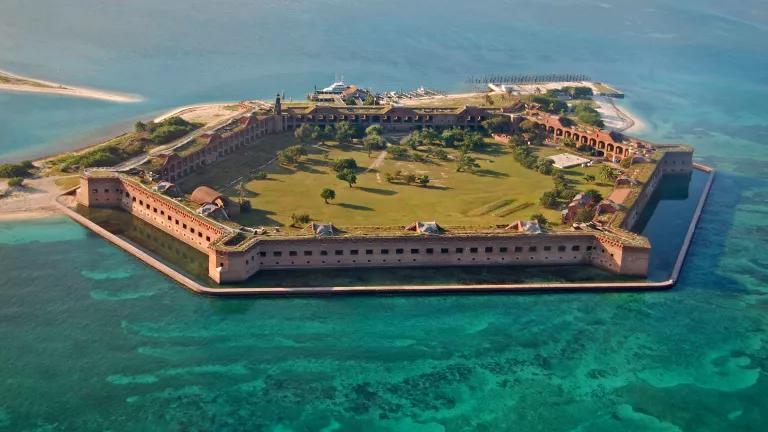Protecting Our National Parks for Another 100 Years
If we don’t address these increasingly severe threats, America’s most treasured lands might soon be unrecognizable.

Fort Jefferson in the Dry Tortugas National Park, Florida
“Europe has cathedrals. We have national parks,” says Stephen Saunders, president of the Rocky Mountain Climate Organization, neatly capturing the significance of these 59 national treasures, which include important monuments as well as parklands. But as we honor their majesty on this 100th anniversary of the National Park Service, we must also recognize and address the biggest threats to our natural versions of Notre Dame.
Climate Change
“We have never before lost a national park,” Saunders says. “But we are on track now to lose some to higher seas.” New York’s Ellis Island, part of the Statue of Liberty National Monument, and Dry Tortugas, the 100-square-mile national park off Key West, are just above sea level. Thanks to heat-trapping pollution, which warms and expands ocean waters, “these parks are at risk of being submerged and disappearing—not just in storm surges, but entirely,” Saunders says.
That pollution also puts our parks at risk for uncharacteristically fierce wildfires. “Hotter, drier conditions mean more intense fires that can permanently change forest to scrubland in beloved landscapes like Yosemite,” notes Niel Lawrence, NRDC’s senior expert on federal forestlands.
Funding Struggles
The enjoyment of national parks is at a record-breaking level, with a predicted 315 million visitors this year (up from 307 million in 2015). While that seems like happy news, the parks are straining under the pressure. “There is a $12 billion backlog of unfunded projects,” says Ani Kame’enui, director of legislation and policy at the National Parks Conservation Association. “There are cracks in the Washington Monument, potholes at Glacier National Park, nonworking faucets at the Grand Canyon—the list goes on.”
On the surface, the most recent government spending bill, passed by the House this summer, seems like an environmental win. It proposes a $2.9 billion budget for the National Parks Service for 2017, which is $79 million more than the previous year’s allocation. But look closer, Kame’enui says, and you’ll see not only that the money is shy of the funds needed to address the backlog, but that tacked on to the bill are a pile of policy riders that undermine the natural resources national parks aim to protect. “For instance, the bill includes provisions to prevent implementation of the Stream Protection Rule, a measure to improve the health of communities near streams from the mountains of West Virginia to the valleys of Tennessee,” she says.

Fossil Fuel Extraction
Areas near national parks are continually subject to the pollution and environmental damage that comes with dirty energy projects, such as oil drilling in the Bakken formation near North Dakota’s Theodore Roosevelt National Park; a large coal mine outside Utah’s Bryce Canyon National Park; and oil and gas drilling around the boundaries of Canyonlands, also in Utah. Big Cypress National Preserve, which recharges aquifers that supply drinking water to much of southern Florida and serves as a watershed for Everglades National Park, is facing threats from extensive oil and gas exploration in pristine wetland areas in the preserve. “Oil exploration has historically happened in Big Cypress preserve,” says Alison Kelly, a staff attorney with NRDC. “But now an oil company is starting one of the largest explorations ever proposed in a national park unit.” The first phase of the four-phase project was just approved, though it is being contested by a lawsuit filed by NRDC and other environmental groups.
Antigovernment Extremists
Long-standing disputes over whether the federal government has the right to own and manage land in the West have boiled over in recent years. In 2014, Nevada rancher Cliven Bundy led an armed standoff against Bureau of Land Management officers; they were trying to confiscate his cattle because he’d refused to pay BLM fees dating back to 1993 for illegally grazing the animals on protected land. In 2015 his son, Ammon Bundy, led a 40-day occupation of Malheur National Wildlife Refuge in Harney County, Oregon, in support of ranchers Dwight and Steven Hammond, a father and son who were convicted of arson for lighting fires on BLM-managed land where they had leased grazing privileges for their cattle. The Hammonds’ attorney said the Bundys did not speak for them, but regardless, the standoff seemed aimed to galvanize opposition to federal control of land. As the local sheriff said in a statement at the time, “These men had alternative motives, to attempt to overthrow the county and federal government in hopes to spark a movement across the United States.”
Sharon Buccino, director of NRDC’s Land and Wildlife program, fears that national parks could be the next targets. “Our public lands are a place for us to unite and connect,” she says. “Extremists like the Bundys seek to monopolize what belongs to us all for their own individual profit and glorify their own freedom at the expense of the freedom of others.”
This NRDC.org story is available for online republication by news media outlets or nonprofits under these conditions: The writer(s) must be credited with a byline; you must note prominently that the story was originally published by NRDC.org and link to the original; the story cannot be edited (beyond simple things such as grammar); you can’t resell the story in any form or grant republishing rights to other outlets; you can’t republish our material wholesale or automatically—you need to select stories individually; you can’t republish the photos or graphics on our site without specific permission; you should drop us a note to let us know when you’ve used one of our stories.

Biodiversity 101
What Biden Should Get Done on Day One (or Close to It)
The Overlooked Importance of Penguin Poop, Fulmar Feces, and Gull Guano